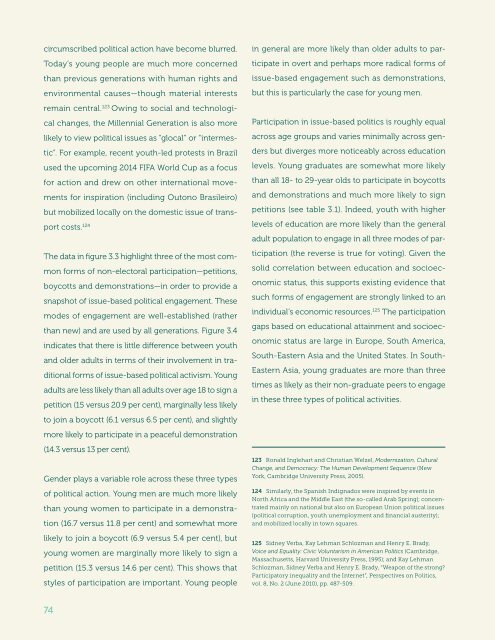YOUTH CIVIC
JieguI2U
JieguI2U
Create successful ePaper yourself
Turn your PDF publications into a flip-book with our unique Google optimized e-Paper software.
circumscribed political action have become blurred.<br />
Today’s young people are much more concerned<br />
than previous generations with human rights and<br />
environmental causes—though material interests<br />
remain central. 123 Owing to social and technological<br />
changes, the Millennial Generation is also more<br />
likely to view political issues as “glocal” or “intermestic”.<br />
For example, recent youth-led protests in Brazil<br />
used the upcoming 2014 FIFA World Cup as a focus<br />
for action and drew on other international movements<br />
for inspiration (including Outono Brasileiro)<br />
but mobilized locally on the domestic issue of transport<br />
costs. 124<br />
The data in figure 3.3 highlight three of the most common<br />
forms of non-electoral participation—petitions,<br />
boycotts and demonstrations—in order to provide a<br />
snapshot of issue-based political engagement. These<br />
modes of engagement are well-established (rather<br />
than new) and are used by all generations. Figure 3.4<br />
indicates that there is little difference between youth<br />
and older adults in terms of their involvement in traditional<br />
forms of issue-based political activism. Young<br />
adults are less likely than all adults over age 18 to sign a<br />
petition (15 versus 20.9 per cent), marginally less likely<br />
to join a boycott (6.1 versus 6.5 per cent), and slightly<br />
more likely to participate in a peaceful demonstration<br />
(14.3 versus 13 per cent).<br />
Gender plays a variable role across these three types<br />
of political action. Young men are much more likely<br />
than young women to participate in a demonstration<br />
(16.7 versus 11.8 per cent) and somewhat more<br />
likely to join a boycott (6.9 versus 5.4 per cent), but<br />
young women are marginally more likely to sign a<br />
petition (15.3 versus 14.6 per cent). This shows that<br />
styles of participation are important. Young people<br />
in general are more likely than older adults to participate<br />
in overt and perhaps more radical forms of<br />
issue-based engagement such as demonstrations,<br />
but this is particularly the case for young men.<br />
Participation in issue-based politics is roughly equal<br />
across age groups and varies minimally across genders<br />
but diverges more noticeably across education<br />
levels. Young graduates are somewhat more likely<br />
than all 18- to 29-year olds to participate in boycotts<br />
and demonstrations and much more likely to sign<br />
petitions (see table 3.1). Indeed, youth with higher<br />
levels of education are more likely than the general<br />
adult population to engage in all three modes of participation<br />
(the reverse is true for voting). Given the<br />
solid correlation between education and socioeconomic<br />
status, this supports existing evidence that<br />
such forms of engagement are strongly linked to an<br />
individual’s economic resources. 125 The participation<br />
gaps based on educational attainment and socioeconomic<br />
status are large in Europe, South America,<br />
South-Eastern Asia and the United States. In South-<br />
Eastern Asia, young graduates are more than three<br />
times as likely as their non-graduate peers to engage<br />
in these three types of political activities.<br />
123 Ronald Inglehart and Christian Welzel, Modernization, Cultural<br />
Change, and Democracy: The Human Development Sequence (New<br />
York, Cambridge University Press, 2005).<br />
124 Similarly, the Spanish Indignados were inspired by events in<br />
North Africa and the Middle East (the so-called Arab Spring); concentrated<br />
mainly on national but also on European Union political issues<br />
(political corruption, youth unemployment and financial austerity);<br />
and mobilized locally in town squares.<br />
125 Sidney Verba, Kay Lehman Schlozman and Henry E. Brady,<br />
Voice and Equality: Civic Voluntarism in American Politics (Cambridge,<br />
Massachusetts, Harvard University Press, 1995); and Kay Lehman<br />
Schlozman, Sidney Verba and Henry E. Brady, “Weapon of the strong?<br />
Participatory inequality and the Internet”, Perspectives on Politics,<br />
vol. 8, No. 2 (June 2010), pp. 487-509.<br />
74


